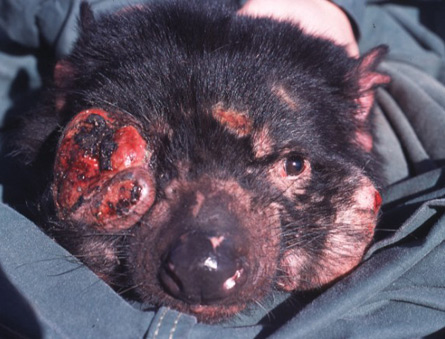Tasmanian devils are mating earlier in response to a deadly,
contagious cancer, a new study reports. The findings, appearing online July 14
in Proceedings of the National Academy of
Sciences, are among the first to show mammals adjusting mating behavior in
response to an infectious agent.
“There has been a sudden increase in the proportion of
females that breed in their first year of life as subadults,” says lead author
Menna Jones, a zoologist at the University
of Tasmania in Hobart, Australia.
“This shift has been fast, within one generation.”

Previously, fewer than 10 percent of the females reproduced in their first year of life. Now up to 60 percent breed in the first year, Jones notes.
“This is a dramatic finding, showing that breeding patterns change as a response to disease,” says Christopher Johnson, an ecologist at JamesCookUniversity’s Townsville campus in Australia.
Tasmanian devils are carnivorous, dog-sized marsupials that inhabit the island of Tasmania, off the southeastern coast of Australia. From a peak around 130,000 to 150,000 in the mid 1990s, the devil population has dropped to between 20,000 and 50,000, according to a report from Australia’s Department of Primary Industries, Water and the Environment.
The devil population has been ravaged by a contagious cancer called Tasmanian devil facial tumor disease, which first emerged around 1996. The disease, which spreads when the frisky devils bite each other, causes huge lesions to grow on a devil’s face and jawbone. All of the infected animals die, usually after the fast-growing tumors make eating impossible. Because the devils lack genetic diversity, they can pass on tumor cells to each other without their bodies recognizing those cells as foreign, Jones says.
Because the disease kills most of the animals by the time they’re 2 years old, early breeding keeps the devil population numbers up. That may stave off extinction long enough for the animals to evolve ways to reduce disease’s impact, Jones says.
With the devil population plummeting, there’s more food to go around, which seems to increase the female devils’ growth rates, Jones says. That could account for their early sexual maturation.
It’s not clear whether the epidemic has led to permanent genetic shifts in when the Tasmanian devils mature, Johnson says. It’s possible that devils who are hard-wired to mature early are able to reproduce, while relatively late bloomers die of the disease before they can have offspring. Over time, those who are genetically programmed to grow up fast may become the norm in the population.
Past studies have shown that deer and commercially harvested
fish can breed earlier in response to heavy predation or hunting pressures,
Jones says. But this is the first time such a shift in sexual maturity has
occurred in response to an infectious disease, she says.






